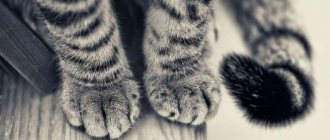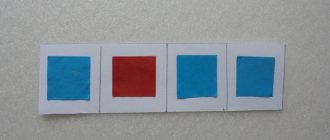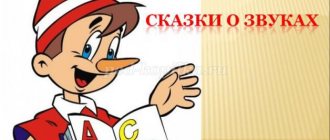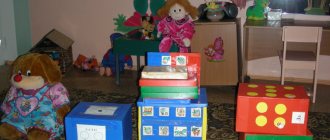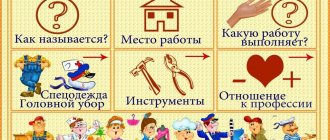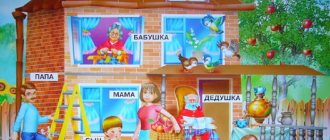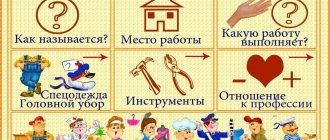Lesson notes No. 3. Topic: “Consonants”
A series of literacy classes for children of senior preschool age (school preparatory group)
“Travel around the country “Write-Read”
Lesson No. 3
Topic: “Consonants”
Target:
Summarize children's ideas about vowels and consonants.
Tasks:
Learning task:
Reinforce the concepts: vowel, consonant, hard, soft, voiceless and voiced.
Developmental task:
To develop children's phonemic hearing, develop attention, memory, thinking, develop vocabulary, develop coherent speech, strengthen the ability to answer questions with a common sentence, and develop the ability to independently draw conclusions.
Educational task
: To foster curiosity, creative activity, develop the skill of independent activity, cultivate in children the ability to work in a team, cultivate interest in activities and love for their native language.
Equipment:
Map of the country “Write-Read”, cards with pictures of objects, cards with consonant sounds, album sheets, colored pencils, blue and green cards made of cardboard, bells, letter Write-Read, sound trees.
Progress of the lesson:
Educator:
Our journey through the country
“Write-Read”
continues.
Today we will again visit a hospitable city called...What is it called (children's answers).
Well done!
But in order to get to the country of “Write-Read” we need to go through a password with you. You are ready? (children's answers).
- Do you remember the names of the city residents? (sounds).
- What sounds are there? (sounds of nature, objects, music and speech sounds).
- What groups are speech sounds divided into? (vowels and consonants)
- How many vowel sounds? (vowel sounds 6)
- How are vowel sounds pronounced? (they can be sung)
- Name the vowel sounds.
- Think of words that begin with a vowel sound. (children's answers)
Well done boys. So we found ourselves in a magical land and in the city of “Zvukograd”
We are already being met.
Who do you think is meeting us? (consonant sounds are placed on the board) (children put forward their versions)
And consonant sounds greet us.
Consonants agree
Rustle, whisper, creak,
Even snort and hiss,
But I don’t want to sing to them.
They don’t know how to sing consonants, they don’t like them. We pronounce consonant sounds with the help of lips, tongue, teeth, palate, and there is an obstacle in their pronunciation. They are pronounced briefly. Some are loud, others are deaf. Some are hard, others are soft. Look at them. What color is their outfit? (children's answers).
If the consonant is hard, then he puts on a blue outfit, and if it is soft, then he puts on a green outfit. Look, there are consonant sounds that have both blue and green colors in their colors. What do you guys think this means? (children's assumptions)
.
This means that there are two sounds: both hard and soft. There are many such sounds, look. (the teacher shows the sounds on the board).
But there are sounds that he doesn’t have, or only hard and soft girlfriends. Or vice versa, only a soft sound, but no firm girlfriend.
Let's name only solid sounds (the teacher shows, and everyone names the sounds in unison)
- [f][w][ts].
And now let's name only soft sounds - [h'][sch'][th'].
Look, soft sounds have this comma at the top right. It indicates that the sound is soft. This comma is called an apostrophe.
Game “Name the consonant sound at the beginning and end of the word”
Subject pictures (house, honey - a consonant sound at the beginning of a word; stork, lynx - a consonant sound at the end of a word). Below the pictures are squares with the number of sounds in a word.
Educator:
I have a picture in my hands.
- What is shown in the picture?
- How many sounds are in a word?
- What consonant sound do we hear at the beginning of a word, at the end of a word?
(the desired square is covered with a green or blue card.)
Educator:
The next game is called
“Guess what sounds there are more.”
I will read poetry, and you guys listen carefully and try to say which sound occurs more often and in which words.
“Ah-ah,” Alenka cried.
“Naaah,” her sister told her.
Raised a scarlet flower
And she gave it to Alyonushka.
(the sound [a] is more common, it is a vowel)
Rain, rain, no rain,
Rain, rain, wait.
Let me get home
To the gray-haired grandfather . (the most common sound is [d] and [d'], it is a hard and soft consonant)
In the silence of the forest,
Whispers rush to rustle,
Whispers rush to rustle,
Whispers rustle through the forest. ( the sound [sh] is more common than others; it is a hard consonant)
Educator:
Consonant sounds, guys, are not only hard and soft, but they are also voiced and voiceless.
To determine which sound is dull or voiced, you need to place your palm on the neck and pronounce the sound. If the neck rattles like a bell ( show bell)
, then the sound is ringing, and if the neck is calm and does not rattle, then the sound is dull. Let's play a game
“Guess what sound.”
I name the consonant sound, and you determine what it is: voiced or voiceless. If the sound is voiced, then you show the bell, and if it is dull, then you just sit quietly. (the teacher names the sounds, the children practice determining the voicedness and deafness of consonant sounds.)
Physical education minute.
Educator:
Guys, let’s show the residents of the city
“Zvukograd”
how we can play fun and teach them one of our games. Come out onto the carpet.
Game "Zoo".
(girls make wishes of animals, and boys imitate them and vice versa)
Game » Can you hear the sound? "
The game is played locally. The teacher shows the children a picture depicting CANCER. Children say loudly: CANCER. Then he shows a picture of a MAC. Children say loudly: MAC.
The words MAC and RAK are repeatedly pronounced by individual children and by all at the same time. The teacher offers to listen to them and say what they have in common - do they sound similar, but what is different? The speech therapist himself clearly pronounces MMak-RRRak, as if singing the initial sounds of these words, and if the children find it difficult, he himself reports that the words sound different at the very beginning, different sounds M and R are heard in them. The exercise is carried out in a similar way with the words KIT - CAT .
Game » What word did you have in mind? "
The teacher shows a picture of a chamomile and says: This is... a chamomile. Children smile and correct: Chamomile. He agrees: that’s what I’m saying: … a mistake. In response, children begin to pronounce the word with a deliberate increase in the sound R: rrr-daisy. But why doesn’t it work out for me, maybe I’m missing something? - Yes. You are missing the R sound.
The teacher informs the children that a letter has arrived from Write-Read. “I am sending you a piece of paper with words. Guess what words I have in mind. The first word is... orova, the second word is dy.... What kind of word is this, tell me children? – cow, smoke
- What didn't sound right?
- What is missing in my word?
Educator
: Well done!
We played great. How do you imagine the country of “Write-Read”
?
(Children's answers.)
In this country, like in any other, there are rivers, lakes, villages, cities and mountains.
But this is an unusual country, because unusual people live in it. We even visited one of the cities with you. Who lives in it? (sounds)
In this city, even the trees are unusual and sound. These wonderful trees grow red, blue and green leaves.
Game
“Sound Tree”
Pictures are given to the children. The child determines the first sound and reports where the word “grows”. Example: the word “car” on a tree with blue leaves, because the first sound in the word is a consonant, hard.
Educator:
Well done boys.
Well, it's time for us to return home. But before they return, you need to pass the password. Ready?
- What two groups are speech sounds divided into? (vowels and consonants)
- How to distinguish a vowel sound from a consonant sound? (vowels are pronounced freely, they can be sung, but consonants are pronounced with a barrier, they cannot be sung.)
- Name the vowel sounds.
- What are the different consonant sounds? (hard/soft, voiced/voiceless)
Educator:
Well done, you completed the task and we returned home, but we will definitely continue our journey through the country of
“Write-Read”.
